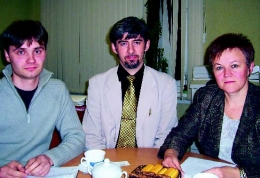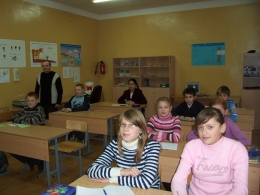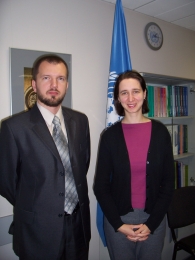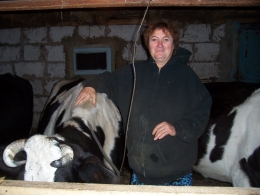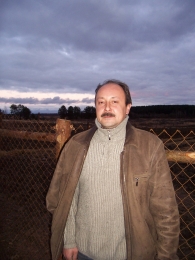Over 20 years on from the Chernobyl nuclear power plant disaster, huge challenges still face those in the most affected areas of Belarus. Development workers and residents in the country’s east tell CATHERINE REILLY how far they’ve come, and what problems remain.
IT’S A Monday afternoon and inside the Vaskovichy Secondary School in Slavgorod district, an unusual but essential lesson is underway. “Today we’ll have a class where we all measure caesium-137 in fresh potatoes,” announces teacher Victor Garelikov, as his nine students look on attentively. This ‘Basics in Survival’ lesson is a weekly one-hour appointment in their lives.
“We take an empty bowl and put it on the weight, so you kids,” instructs Garelikov, “put down 120 grams.” The pupils begin jotting in their copybooks. “Then we’ll fill it up with potatoes, and put it on the weight: 720 grams minus 120 grams,” continues their teacher. “So how much potatoes would be in the bowl, 600 grams, right?” The students agree.
Garelikov then presses in the co-ordinates into special measuring apparatus to gauge how much caesium-137, a radioactive and cancer-inducing substance, is present in the foodstuff. It falls within the acceptable range (admissible levels are set out in Belarusian legislation).
“All foodstuff served to the children in this school goes through radioactivity control,” explains Vasiliy Ryzhkov, director of the radiological centre at the school. Foodstuffs from the forests are more likely to show readings beyond the acceptable level, it is explained.
The centre, which assists children and their families acquire practical skills in reducing the risk of radiation exposure, was established in 2005 with support from the United Nations Development Programme (UNDP) Belarus under the Core initiative.
Core (Co-operation for Rehabilitation of living conditions in Chernobyl affected areas) has been a five-year partnership programme between the Belarusian government alongside national and international organisations, focusing on four of the districts affected by the 1986 Chernobyl disaster: Slavgorod (Mogilev region), Bragin (Gomel region), Stolin (Brest region) and Chechersk (Gomel region). Locals in these four affected areas have helped initiate over 140 projects in healthcare, economic/social development, and radiological awareness.
“The issue of radioactivity became a constant in our life,” admits Ryzhkov, “and we have to know how to live with it. The Core programme was very helpful for us in establishing the centre.” The Vaskovichy centre is open Mondays to Saturdays from 9am to 5pm, he says, and also contains “other tools in order to measure the contamination level of the air”.
Is the radiation measuring equipment portable and moved around the communities? “Well actually this centre doesn’t have that necessity,” he replies, “because there is one centre which is run by the government and they are doing that – they are moving out the equipment and making measurements.”
One gets the impression that the children are the main beneficiaries of the Vaskovichy centre. Adults in the locality must decide for themselves whether to check foodstuffs, as it is not obligatory. “It’s on a voluntary basis,” confirms Ryzhkov. “However, with such items as milk products, vegetables and mushrooms, the people are interested to check.” Pupils, though, are obliged by the school to bring in foodstuffs and measure them themselves.
Are they enthusiastic about using such equipment? “Da!” – Yes! – the class responds at once.
LIFE CONTINUES in the Chernobyl-affected areas despite big challenges, emphasises Anna Litvinova, programme officer with UNDP Belarus, which is headquartered in Minsk. Residents are neither victims nor survivors, just everyday people who were dealt a very tough hand.
Since 2004, the UN has shifted its focus from humanitarian assistance to development in the Chernobyl-affected areas. And aside from the exclusion zones (from where people have been permanently moved), Litvinova explains that development is possible.
“These areas do require extra resources because for many years they’ve been getting small opportunities,” she says. “In some cases it was not even clear if those territories would continue to be populated. People live there – they’ve voted in some respects. They were born in the area and want to continue living there. And they can do it so long as they follow some practical precautions. So since 2004, the focus became on the long-term sustainable development in these territories.”
Litvinova says that promoting healthy living is paramount. “If you follow a healthy lifestyle and take into account the environment – a low dose radiation environment – and follow some basic rules, then basically you are in charge of your health, that would be the right message to say here,” she says.
“It’s quite a big issue in Belarus because many people think that medicines and doctors will do everything – it’s true for the Chernobyl-affected areas as well. In reality, medicines and doctors are only responsible in part for what constitutes human health.”
Basic safety information generally gets out there, suggests Litvinova, but some take it, and some leave it. “If you take the issues that are very pertinent to the Chernobyl affected areas, such as the fact that the bulk of the radionuclides comes with food, most of them know that fruit of the forests really have a high risk of having accumulated radionuclides. But [some] still go into the forest and still get mushrooms and berries and eat them.”
The radioactive fallout from Chernobyl landed in spots, she explains, and this can lull some into risk-taking. “You may have a village where, if you go westwards you end up in a contaminated forest; if you go eastwards, the place could be considered clean compared to the other one. In the same village you will have people who are going westwards and people going eastwards, and having equal access to information. But it will be their decision.
“Those who go westwards to contaminated areas, they will say ‘Oh I can’t see radiation,’ or ‘I don’t believe the information that I get,’ or ‘Who cares? After all, we all die.’” A difficult mindset to budge, it has meant that international donors have started shifting their focus to children and more perceptive groups such as pregnant women and new mothers, she explains.
“In the rural areas, where people have lower incomes, they have no other choice,” adds Litvinova, “but at least they can use simple techniques of cooking fruit of the forests which would allow for reducing the radionuclide content in their foodstuff.”
In addition to having provided administrative support to the aforementioned Core project – which concludes this month – UNDP Belarus has a wide range of initiatives targeted at Chernobyl-affected areas. One example, co-funded by USAid, is a health project in the Stolin district which raises awareness among mothers, pregnant women, and their families, about reproductive health and radiological issues.
Another, with support from the UN Security Trust Fund, will provide information on radiological and reproductive health, assist agricultural smallholders, raise awareness among the female population about mammary gland health, and procure equipment allowing a mobile team to reach isolated villages to do ultrasound exams. Furthermore, a European Commission-funded project is in the pipeline which will focus on the development of a thyroid disease centre, offering countrywide services, and community mobilisation in the Gomel region.
Significant funds are being pumped into such projects, the latter attracting EC funding of €2.4m, for example. But it’s getting tougher to draw partners, admits Litvinova.
Her colleague, communications specialist Vladislav Khilkevich, confirms that Chernobyl is generally not even a top topic within the Belarusian media (aside from increased coverage around the anniversary in April), but the involvement of tennis star Maria Sharapova in some of its projects does ignite interest from the national press.
“Chernobyl is becoming an issue that’s getting a little old in terms of attracting attention,” Litvinova continues. “We’re doing our best to ensure that donors keep remembering that this is an issue that remains here and which has a long-standing character.” Belarus is moving upwards in the welfare classification to the level of middle income countries, so “technically the country seems to be doing more or less alright”. However, Litvinova emphasises that Chernobyl-affected areas “constantly need resources” in terms of promoting healthy living and producing clean food.
“Someone might think that now the arable land is all right – they use the techniques – but the point is if you stop using these techniques, which cost quite a lot, if you stop applying the fertilisers on top of what the other regions are doing, then next year you will have a contaminated harvest so it is an extra financial burden.
“Belarus, of course, has already invested unprecedented amounts of resources and this will continue, but it still needs help to make sure that the people living here can live good lives.”
The dubious political system in Belarus has contributed to some global scepticism over the government’s more optimistic Chernobyl recovery statements, but Litvinova has genuine praise for the authorities’ commitment in this regard. “I think actually our work is being led by the fact that they keep paying attention to this issue,” she comments.
A STATUE OF Vladimir Lenin stands stoically outside Belarus’s parliament building in Minsk – another reminder of the semi-Soviet aura in the country. But some things have moved on.
“Years ago, when I used to work in my district,” begins parliamentarian Larisa Vershalovich, “the top government officials would come to see how we live, and they would bring bags of food with them because they were scared to death of eating the foodstuffs which we were taking.”
From the Brest region in the south-west – an area badly affected by Chernobyl – Vershalovich is deputy chairperson of the parliament’s Committee on the Chernobyl Catastrophe, Ecology and Nature Management.
She explains that the government is on its fourth programme (2006–2010) on tackling the disaster’s consequences, and economically, the damage will continue to hurt. An official press release says the country’s economy will suffer losses of $43.3bn in the first 30 years after the accident (according to figures from the Institute of Economics of National Academy of Sciences). The total monetary damage is projected to be $235bn over this period – 32 times the national budget for 1985. Chernobyl-related costs accounted for 22.3 per cent of the country’s national budget in 1991, 10.9 per cent in 1996 and about six per cent in 2001. Presently, the figure stands at approximately four per cent.
“Every year, the parliament votes for the state budget, and funds are allocated to combating the consequences of the disaster, remarks Vershalovich, who says the amount provided this year adds up to $400m.
Right now, she says, the key focus points concern agricultural and economic regeneration of the affected territories, and continuing health issues. “Kids in the worst affected areas get meals twice a day at school,” Vershalovich continues, “Also the money is allocated to purchase modern medical equipment. For example, I am from the Luninetsk district in the Brest region, and we have spent a big amount of money on state-of-the-art equipment.”
Over time, the level of contamination gets lower as the radionuclides begin to disintegrate, Vershalovich continues. “This is controlled, and in the areas that are considered less contaminated, the people get less preferences, which sometimes they do not like.” Children’s recuperation trips to countries such as Ireland are much appreciated by Belarus, she adds, primarily because they broaden horizons and promote international friendships.
Tellingly, Vershalovich concedes that the full consequences of the Chernobyl disaster are probably not yet known. “We are speaking about small doses of radiation and it has not been studied in detail yet how those small contamination doses affect the human body,” she admits. “For example, today it is absolutely known that there is a relation between thyroid cancer and Chernobyl, because in 1986 there was a big pressure coming from the radioactive iodine which was in the air and soil. There are certainly several diseases which are affected or stimulated by radioactivity because the immune system is damaged. And there is one more factor – a psychological factor for the people living in the territories. It is very bad that a part of the population has a feeling of them being a victim.”
She credits the Core programme with helping to combat this. “There are four districts that participated in the Core programme. I believe it’s very important and good that the people living in the contaminated areas try to live actively and care about their health and bodies.”
BACK IN Slavgorod district in the Mogilev region, Valery Zhukov, director of an agricultural foundation aimed at assisting smallholders, explains that after the Chernobyl disaster, rehabilitation and support measures were targeted to state collective farms, leaving the smallholder far behind.
Zhukov was a technician in the Core Agri programme, from which the agricultural foundation (Renaissance Agro) has sprung. Core Agri has helped rural residents to develop skills in agricultural and economic activities and improved access to credit and financial resources, with the French Professional Agricultural Association of International Co-operation for Rural Development (Fert) being guarantor to a €30,000 loan fund in two districts, for example.
“While the programme was developing, the people of Slavgorod district decided to have some legal entity in order to represent their interests on a global scale,” explains Zhukov. “So last year we started that legal entity and the name of that organisation is called Renaissance Agro.”
It does not have the right to engage in commercial activities, he says, but can help farmers with information, business plans and accessing some financial services. A chief partner in the operation is the International Foundation for Rural Development, and its director Siarhei Tarasiuk explains that Renaissance Agro has established an innovation fund which is contributed to by local smallholders.
This fund can be accessed by farmers in order to enhance their agricultural activities through repayable loans. Without such a mechanism, most farmers would not have enough income to prove to a bank that they can make repayments, he explains.
But what is the consumer attitude to goods produced in this Chernobyl-affected area? “We’ve not seen any direct refusals, and I’ll tell you why,” replies Valery Zhukov. “First of all, there’s a special technology to grow agricultural stuffs which allows us to get as less radioactive components as possible. Secondly, this has been checked in special laboratories, and only then does this produce get into the market.” A quality certificate must be issued, he explains.
“I’ve never heard of any cases where the produce was neglected or not accepted because it was coming from here,” he continues. “Certainly, an important role is played by the state certification. It is a good filter.”
Locals in the village of Popovka in Slavgorod district speak in awestruck tones about Galina Melnikova, and when you finally meet her it’s easy to see why. A magnetic woman in her late fifties, she oozes an easy confidence and charisma, and is imbued with a strong work ethic, which her 15 cows can no doubt attest to.
“She was the first in the district to decide to have 15 cows and now she wants 30 cows,” Tatyana Chebotar, another member of Renaissance Agro, tells me. “She was the first one to buy dairy machinery to milk the cows, she did it through the help of the foundation [Renaissance Agro].”
Inside the cow shed, Melnikova begins outlining her philosophy and motivations. “It is better to work with cows than people,” she tells me frankly. “If you’re honest with them, they’re honest with you. The cow shall have the same comfort as you have. She should have enough of food, be warm, have enough to drink, and be clean.”
Some smallholders tend to cut costs, she says, but they don’t realise that innovation and investment will enhance profits. Through Renaissance Agro, she got $5,000 to buy four extra cows, nutrition supplies, and better equipment. Will she be able to pay this money back? “Yes,” replies Melnikova, “no problem.”
Her work, which literally lasts from daybreak to nightfall, is motivated by a desire to fund her children’s education, she explains. Employment prospects in the locality are far from bright, and many young men depart for Moscow’s construction sites. Melnikova’s youngest is 18 in January, and currently at university. “There are only two factories in the district, you cannot make much money in the district,” she says. “I’m already a pensioner so I cannot go to Moscow to work. So here, I make $1,000 a month and this is a big amount of money.” The milk is then sold to a government milk factory.
“In the early 1990s it was not allowed to have so many cows,” she adds, “but now they [the government] say ‘work’. So the people who do not drink, they work.”
Vladimir Akulov is a local berry farmer who has also benefited from the innovation fund. “I’ve a non-standard family, one man and five females,” he jokes. “In order to make their future more promising I decided to deal in agriculture. I approached the foundation in order to help me financially – which they did.”
Looking out at his plot, he seems more than satisfied with how things are going.
MEANWHILE, the Core programme fulfils its remit this year, and its dedicated co-ordinator Zoya Trafimchik feels it has made a major impact. The work will be reviewed, and a decision taken on whether to launch another programme in the same vein.
With some 21 Chernobyl affected districts throughout Belarus, and around 1.5 million out of Belarus’s population of 10 million living on contaminated ground, there is surely much scope for an expanded initiative of some kind.
“As of today, the attitudes of decision makers are very positive about Core,” she comments. Some problems were encountered and remain to be overcome; one is attracting partners for economic efforts, she says.
But generally speaking, Trafimchik indicates that objective number one was achieved, and that was empowering the local communities. “You know, during the visits to the four districts, the first question everywhere was ‘What will you bring to us?’” she recalls of her team’s initial excursions. “Our answer was everywhere the same – rather strong maybe, but honest – ‘Nothing.’ People went ‘How?’ For 20 years or 15 years, there has been humanitarian assistance, equipment, products, and there is a group saying there will be nothing. And after that, we started real conversations – very open, very honest… They are ready and we are ready to move from victims to partners. And they are great partners.”
Her colleague Alexei Tchistodarski underlines that the 146 projects undertaken under Core “are actually the ideas of the local people because in the Core programme, we didn’t impose any idea from afar. We just facilitated them.”
Trafimchik sounds her agreement, and adds: “My feeling, at least in those four districts, is that there is a change. There are changes in people’s mentality, because they are more proud and less victims. They try to prepare a project, and then implement a project. They need to be partners.
“As for me, I don’t want to be ‘victim, victim, victim’ because it’s something difficult – the heritage of victims we would be transferring to our generations. I’m not sure it’s a good thing for our families, for our children, for our country, and for the world itself.”
Chernobyl's hidden health consequences
On 26 April 1986 at nearly 1.30am, reactor number four at the Chernobyl nuclear plant, near Pripyat in Ukraine (then part of the Soviet Union), exploded. Four hundred times more fallout was released than by the atomic bombing of Hiroshima. Areas of Ukraine, Russia and especially Belarus were highly contaminated as a result.
Belarus was most affected as the noxious radionuclides (most notably caesium 137, iodine 131 and strontium 90) were carried north by the wind in the days after the accident. Caesium 137 (with a half-life of 30 years) was the most widely distributed long-lived radioactive element after the disaster. The accident has left its radioactive fall-out trace on 23 per cent of the territory of Belarus.
The health affects of the disaster continue to be hotly contested. At least 1,800 children and adolescents in the most severely contaminated areas of Belarus have contracted thyroid cancer because of the reactor disaster. But some scientists estimate that the catastrophe may ultimately generate up to 100,000 additional cases of thyroid cancer, potentially traced back to the Chernobyl disaster.
The WHO predicts that in the Gomel area in south-east Belarus, one third of all children who were aged four and under at the time will develop thyroid cancer in their lifetime – a total of 50,000 people. It is internationally recognised that breast cancer incidences have risen due to the catastrophe, with cases more than doubling in Gomel.
An international consensus also points to the fact that radiation can induce genetic effects. Feelings of hopelessness, victimhood and economic stagnancy are further outputs of the disaster.
deputyeditor@metroeireann.com
